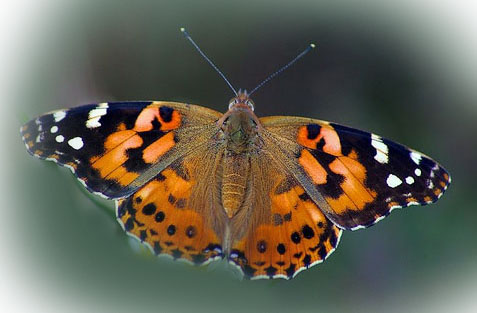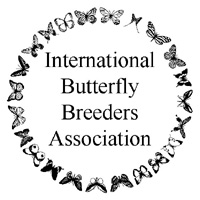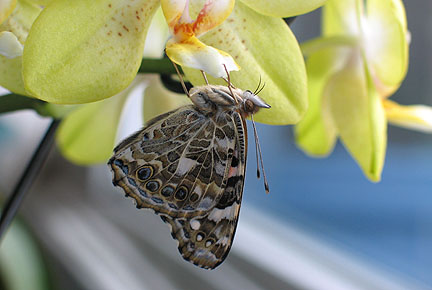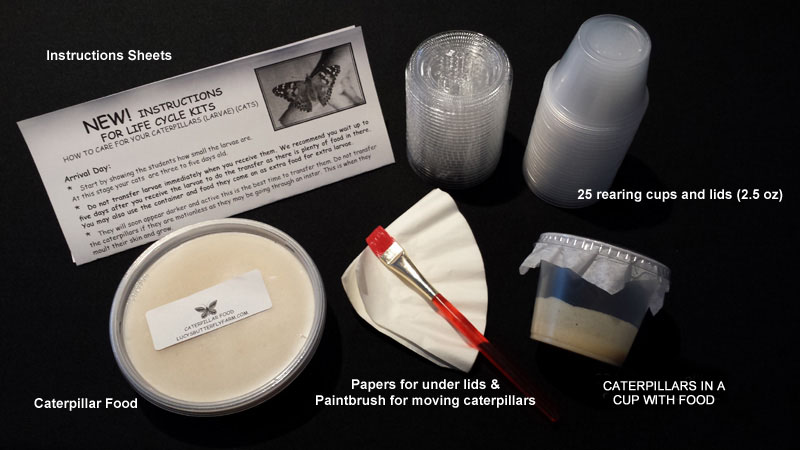We are proud members of the International Butterfly Breeders Association. The IBBA is an international, non-profit, membership-based trade association promoting high standards of ethics, competence and professionalism in the breeding of quality Butterflies.
.
.
NEW! INSTRUCTIONS FOR PAINTED LADY KITS
HOW TO CARE FOR YOUR CATERPILLARS (LARVAE) (CATS)
Arrival Day:
* Start by showing the students how small the larvae are. At
this stage your cats are three to five days old.
* Put your caterpillar food in the fridge.
* It’s not necessary to transfer larvae immediately when you receive them. We recommend you wait a few days after receiving the larvae to do the transfer as there is plenty of food.
* The cats will soon appear darker and active. This is the best time to transfer them. Do not transfer the caterpillars if they are motionless as they may be going through an instar. This is when they moult their skin and grow. They don’t like to be disturbed at this point so you can wait another day or two.
HOW TO CARE FOR YOUR CATERPILLARS (LARVAE) (CATS)
Transferring Larvae:
* Take your caterpillar food out of the fridge.
* Count the number of caterpillars and divide the food evenly. There should be 25 to 27 for the Class kit, 15 to 17 for the Home kit, 10 for the Starter kit. There is enough food provided for all and a little extra as well.
* Wipe the condensation off the food with a clean paper towel. Using a knife, cut the food into chunks evenly to the number of cats you have and divide it between the small containers. Transfer the food first, then using the paintbrush, transfer the larvae, Then place the paper over the container and close the lid tightly. The paper and the three drilled holes in the lid are for best moisture control. (No extra holes are required.)
* If you have extra cats you can place two cats in one container and just add an extra chunk of food. You may also use the container and food in which they arrive as extra food for any extra larvae.
We ship a few extras in case of losses. If you experience losses of 30% or more please
contact us immediately. Handle the larvae as little as possible especially during an instar or pupation.
* Remember to keep the lids securely on at all times as they are little escape artists.
* Take care not to shake or tip the container after the food and caterpillars are placed inside
so the food does not roll on top of the little critters.
* We do not recommend that you assign one caterpillar to each student. This project is best enjoyed as a group learning experience.
CATERPILLARS GROW BIGGER
* Please leave the containers on a shelf at room temperature away from direct sunlight.
Sunlight will cause condensation and excess moisture which is not healthy for the caterpillars.
* The caterpillars will keep on eating the special diet, which is a combination of soy, wheat germ and other nutrients for a several days. Caterpillar droppings look like little balls and are also know as
“frass.”
* When the caterpillar has eaten more than half it’s food you can sweep out the webbing and
the frass. Make sure to leave the remaining food. You may rest the caterpillar on the lid while you do this sweeping. Make sure to put the paper back under the lid for humidity control. If you need to replace the paper (if it gets too wet or torn) use clean, dry coffee filter paper. We recommend you sweep out the frass at least twice to keep the frass from covering the food.
The Chrysalis or Pupa:
* When you see red frass balls, the caterpillars have finished eating. They will soon attach themselves to the paper under the lid, hang upside down in a “J” form and transform into a pupa (without your help) Do not disturb the caterpillar or pupa for at least 48 hours until they have dried and hardened. The pupa is dry when it’s a light brown colour with little gold flecks.
* Start with a clean flight cage. Line the bottom of the flight cage with paper towels.
* Cages can be cleaned of meconium after use each year with a solution of 5% bleach in cold water and rinsed well with hot water. Dry and store flat in a dry place.
* After hardening do not pull the pupa away from the paper. Take the paper with the pupa attached from the feeding container and using a straight pin, pin the paper onto a netted side of the flight cage (not the top) hanging down in a natural position.
* If a pupa does not attach itself properly to the paper or falls off just rest it on the bottom of your flight cage, on top of the paper towel and the butterfly should emerge as usual
* The pupal stage will last eight to ten days depending on how warm the room may be. Please never leave the insect in any form in direct sunlight until release.
Emergence: Meconium Will Appear
* Do not be alarmed by the red liquid that you see during emergence, it’s not blood. It’s called meconium and the butterflies use this fluid to pump up their wings.
* After emergence the butterfly will pump up it’s wings with the meconium. It will take a couple of days for the wings to dry. Until then they are a bit floppy and wet.
Nectar:
* The butterflies will eventually need to nectar after emergence.
* Sliced oranges will do as nectar or a little orange Gatorade (yes, the sports drink!) Soak a few cotton balls and place them on a plastic deli lid at the bottom of the flight cage. This will attract them if they are thirsty and ready to nectar and provide the sweetness they require. You may see their little proboscis tube unroll for feeding.
Mating:
* You may witness mating within three to five days of emergence. If you see two butterflies attached, they are mating. Please do not disturb!
Releases:
* Releases should be planned in time for egg-laying which usually occurs from 5 to 7 days after emergence. Please be sure to release on a warm day (24C is best), never in the pouring rain, and well before six pm. Cooler days are fine but frost overnight is not.
They are beautiful and hardy butterflies. Enjoy your Painted Ladies and Gentlemen.
Lucy Perna, Butterfly Farmer 705-656-1645
lucy@lucyperna.com, www.lucysbutterflyfarm.com
CLICK ON THE PAINTBRUSH ICON TO DOWNLOAD INSTRUCTION SHEETS for the
PAINTED LADY CATERPILLAR KITS.
(There are two pages)





